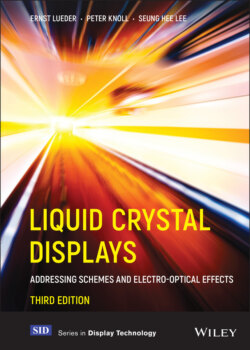Читать книгу Liquid Crystal Displays - Ernst Lueder - Страница 39
4.3 Electronically Controlled Birefringence for the Generation of Colour
ОглавлениеWe consider the mixed mode TN cell for the angle of the polarizer α = π/4 with the intensity
Figure 4.12 The reduced intensity of a mixed mode TN display versus λ = πdΔn/a with Δn (VLC)
in Equation (4.84). The maxima of Isx′ for are plotted in Figure 4.10. Aplot of Isx′ versus λ = πdΔn/a with maxima for is shown in Figure 4.12. By changing Δn we are able to shift the wavelength λ of the maxima, or in other words, we can shift the colour of the transmitted intensity. The birefringence Δn = n|| − n┴ = ne − n0 can be changed by applying a voltage VLC, which gradually tilts the LC molecules in Figure 4.13 forΔε > 0 from the homogeneous alignment in the field-off state to the homeotropic alignment. This effect is called Electronically Controlled Birefringence (ECB). Normally incident light in Figure 4.13 always experiences the same index n┴, whereas n|| changes with the tilt angle Θe(VLC), which depends upon VLC. In Chapter 6, n|| (Θe) will be derived as
(4.103)
The dependence of Θe on VLC can be determined from the mechanical properties of the LC material, which is not discussed further here. The result is a voltage-dependent birefringence
(4.104)
Figure 4.13 The tilt of the LC molecules under the influence of a voltage VLC for Δε > 0
Figure 4.12 shows the intensity for the field-free state with Δn(0) in Figure 4.10 and for a Δn(VLC) = (1/2)Δn(0) with dashed lines as an example. Figure 4.9 shows measured transmission curves of an STN display versus λ, with VLC as a parameter.
The generation of colour by ECB replaces the colour filter by applying an individual voltage to each pixel corresponding to the desired colour. The achievable colours are not fully saturated because the spectral curves are not narrow enough, and neighbouring colours overlap. The reflective cells are constructed according to Section 4.2.4.
